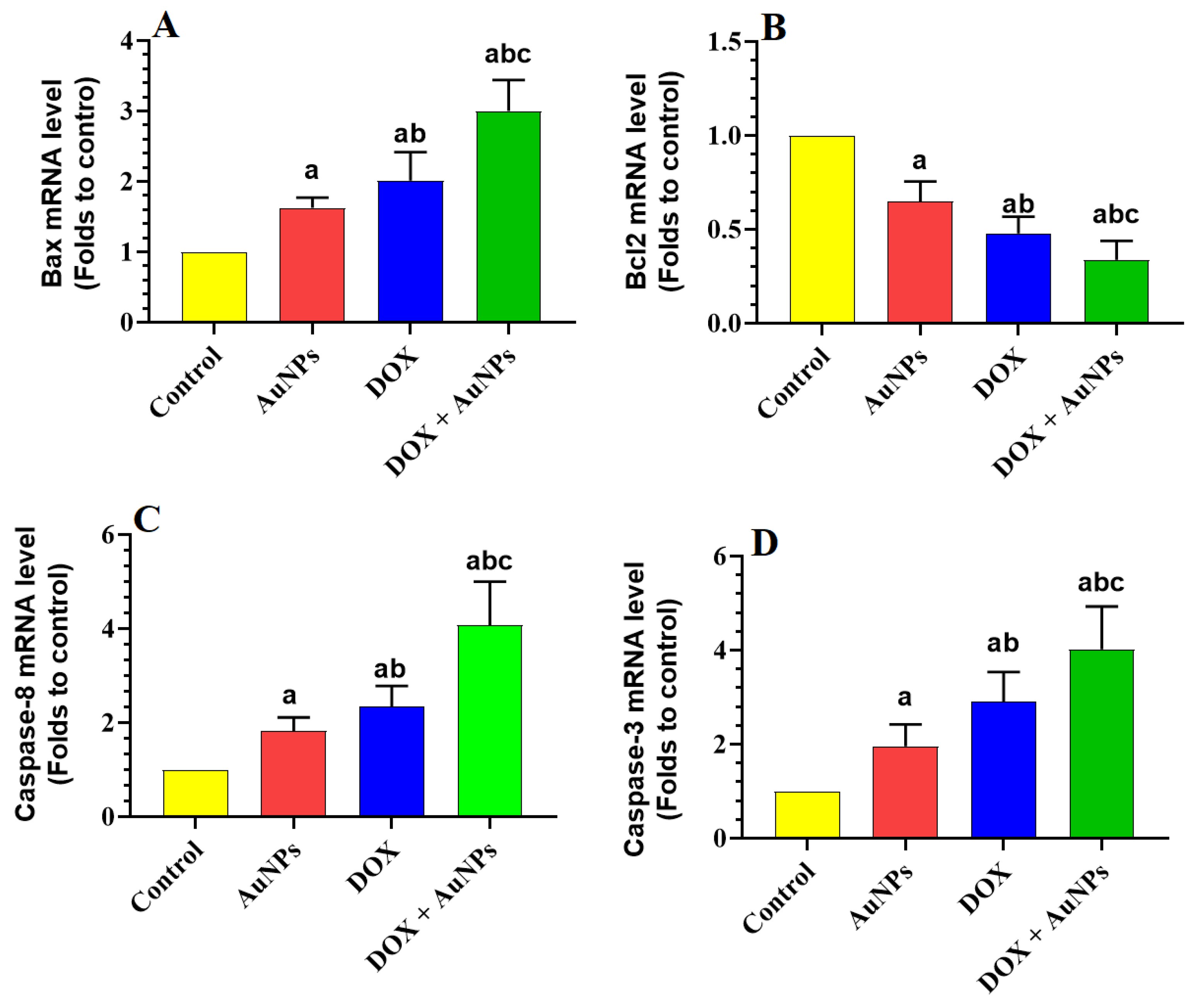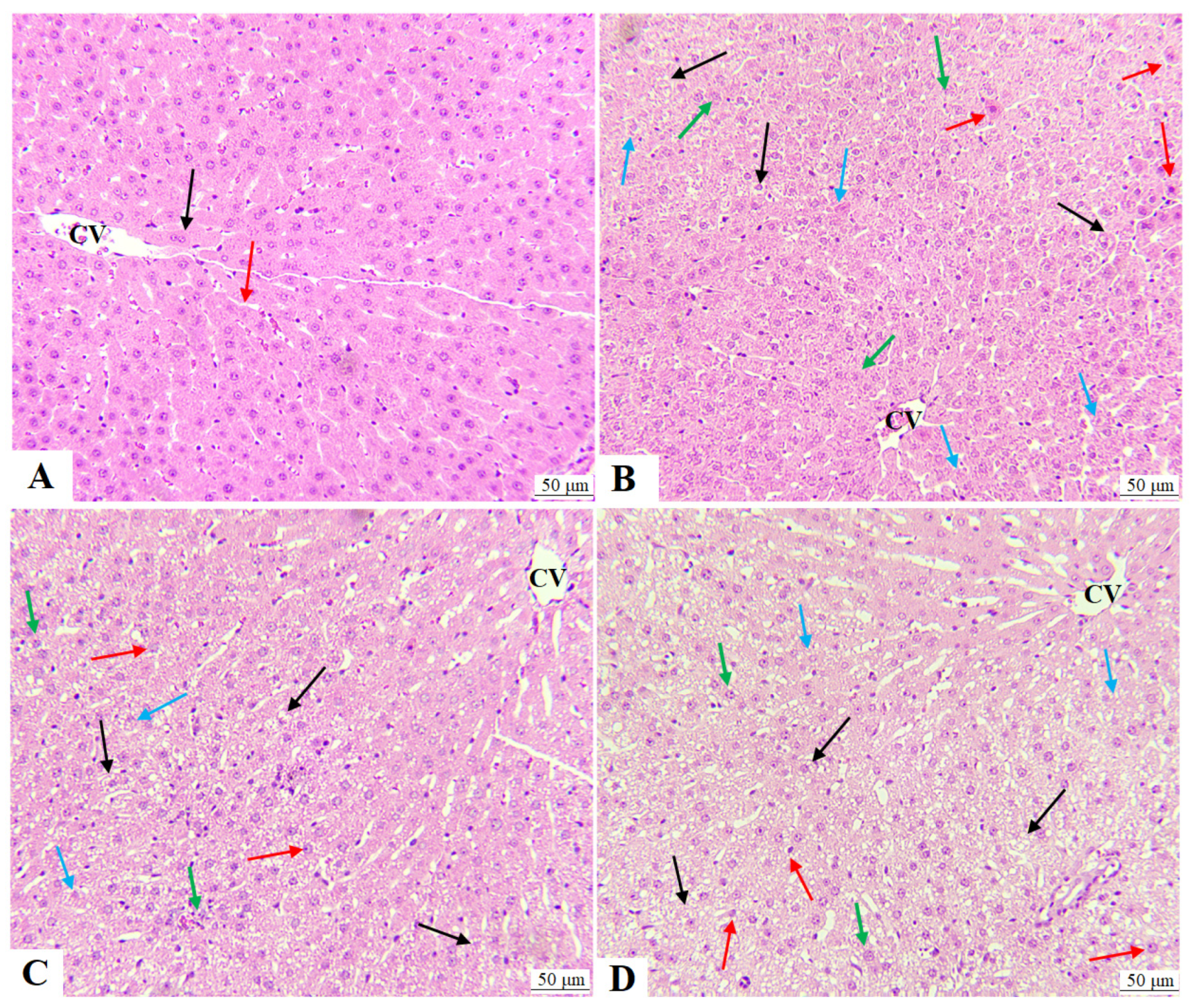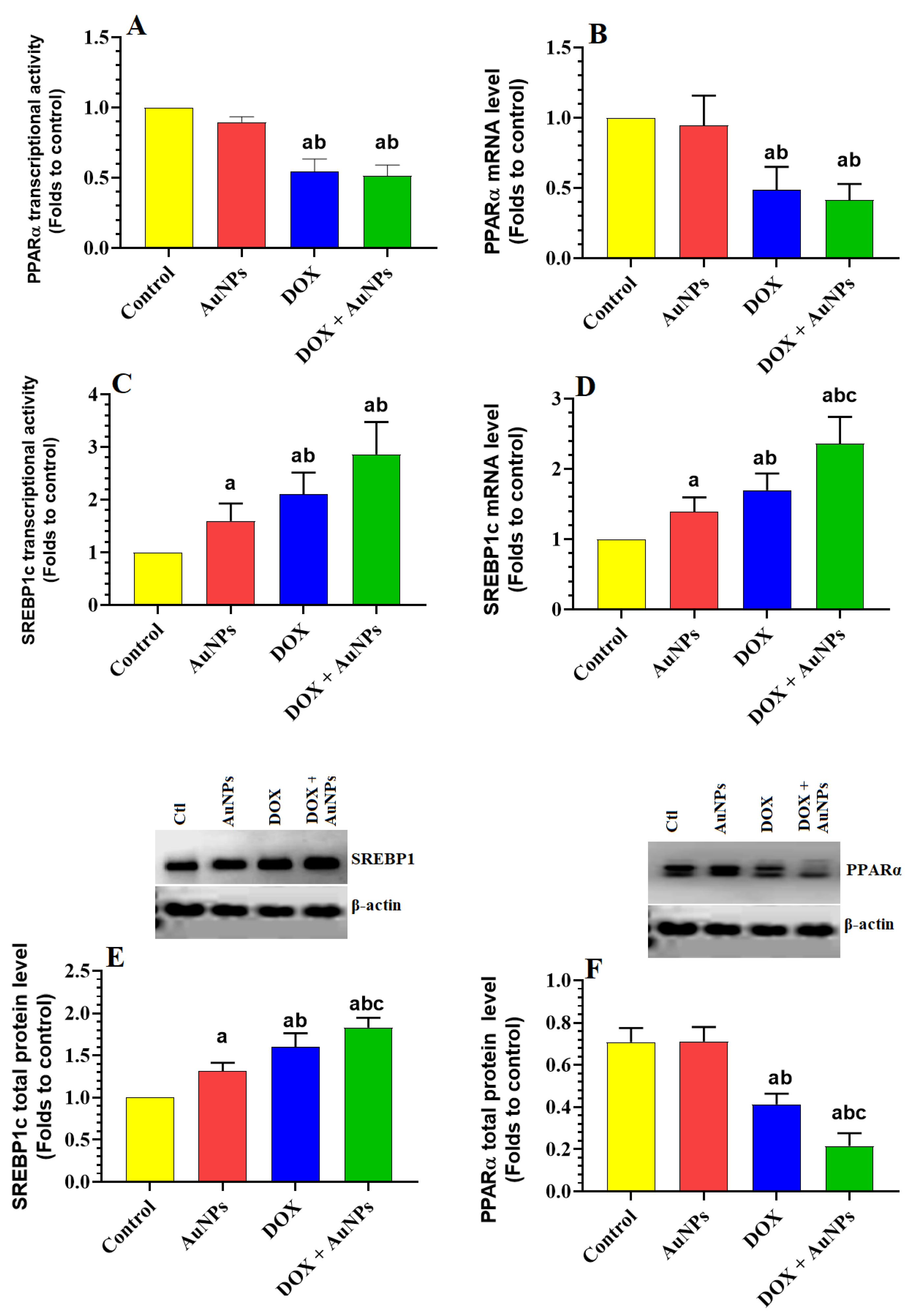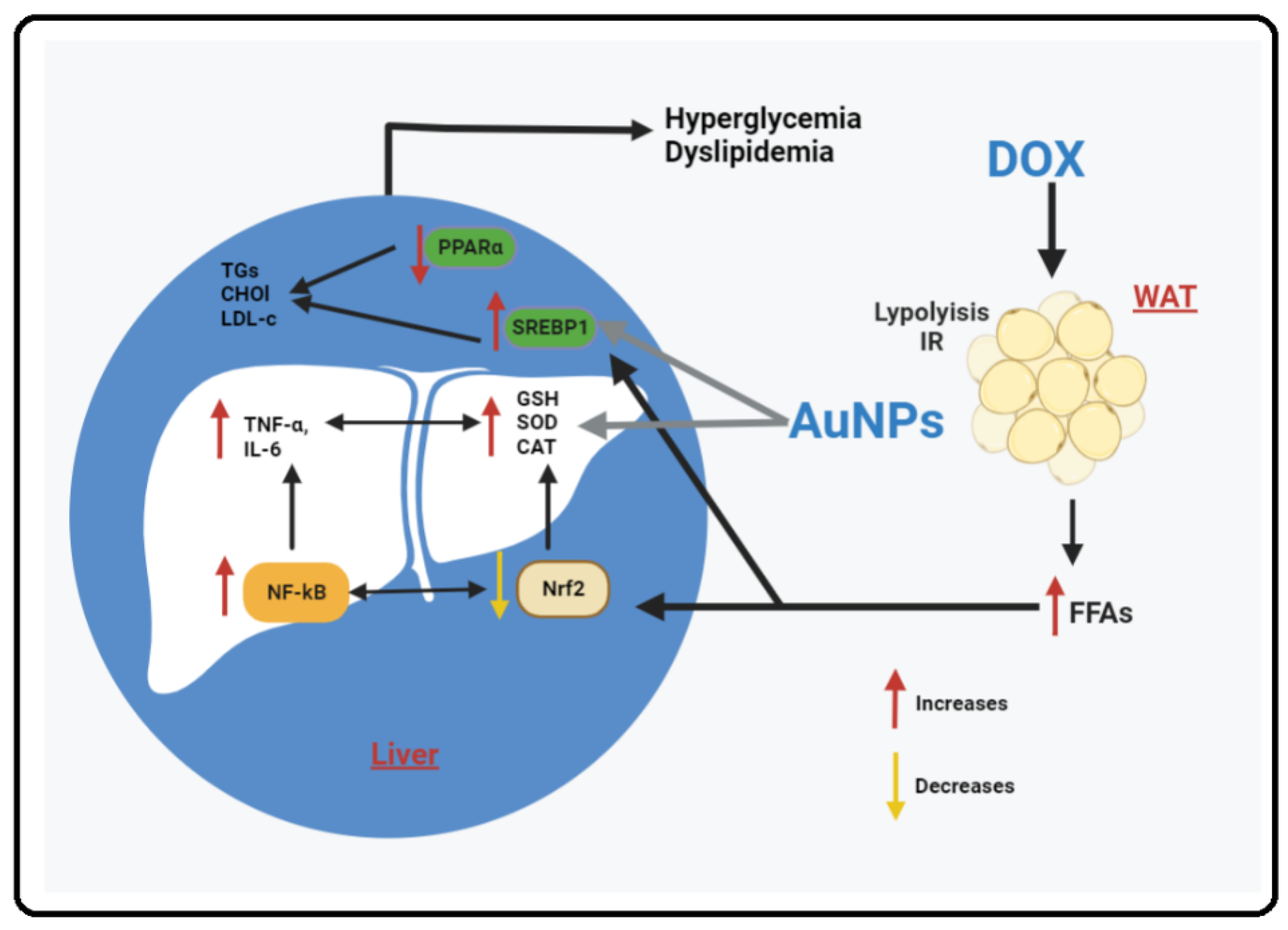Concomitant Sub-Chronic Administration of Small-Size Gold Nanoparticles Aggravates Doxorubicin-Induced Liver Oxidative and Inflammatory Damage, Hyperlipidemia, and Hepatic Steatosis
Abstract
1. Introduction
2. Results
2.1. Changes in Food Intake, Body Weights, Glucose and Insulin Levels, and Liver Enzymes
2.2. Changes in Liver Weights and Serum and Hepatic Lipid Profile
2.3. Changes in Hepatic Pro-Oxidant, Antioxidant, Inflammatory, and Apoptotic Markers
2.4. Histological Findings
2.5. Effect of the Activity and Expression of SREBP1 and PPARα
2.6. Changes in the Transcription, Total Levels, and Nuclear Levels of Nrf2 and NF-κB p65
3. Discussion
4. Materials and Methods
4.1. Animals
4.2. Drugs
4.3. Experimental Design
4.4. Tissue and Blood Collection
4.5. Extraction of Hepatic Lipids from the Freshly Collected Livers
4.6. Preparation of Liver Homogenates and Nuclear Fractionation
4.7. Biochemical Analysis in the Plasma
4.8. Biochemical Analysis of the Serum and Tissue Homogenates
4.9. Real-Time PCR (qPCR)
4.10. Western Blotting
4.11. Histological Evaluation
4.12. Statistical Analysis
5. Conclusions
Author Contributions
Funding
Institutional Review Board Statement
Informed Consent Statement
Data Availability Statement
Acknowledgments
Conflicts of Interest
Sample Availability
References
- Maor, Y.; Malnick, S. Liver injury induced by anticancer chemotherapy and radiation therapy. Int. J. Hepatol. 2013, 2013, 815105. [Google Scholar] [CrossRef] [PubMed]
- Sharma, A.; Houshyar, R.; Bhosale, P.; Choi, J.-I.; Gulati, R.; Lall, C. Chemotherapy induced liver abnormalities: An imaging perspective. Clin. Mol. Hepatol. 2014, 20, 317. [Google Scholar] [CrossRef] [PubMed]
- Song, S.; Chu, L.; Liang, H.; Chen, J.; Liang, J.; Huang, Z.; Zhang, B.; Chen, X. Protective effects of dioscin against doxorubicin-induced hepatotoxicity via regulation of Sirt1/FOXO1/NF-κb signal. Front. Pharmacol. 2019, 10, 1030. [Google Scholar] [CrossRef] [PubMed]
- AlAsmari, A.F.; Alharbi, M.; Alqahtani, F.; Alasmari, F.; AlSwayyed, M.; Alzarea, S.I.; Al-Alallah, I.A.; Alghamdi, A.; Hakami, H.M.; Alyousef, M.K. Diosmin Alleviates Doxorubicin-Induced Liver Injury via Modulation of Oxidative Stress-Mediated Hepatic Inflammation and Apoptosis via NfkB and MAPK Pathway: A Preclinical Study. Antioxidants 2021, 10, 1998. [Google Scholar] [CrossRef] [PubMed]
- Quiles, J.L.; Huertas, J.R.; Battino, M.; Mataix, J.; Ramírez-Tortosa, M.C. Antioxidant nutrients and adriamycin toxicity. Toxicology 2002, 180, 79–95. [Google Scholar] [CrossRef]
- Barakat, B.M.; Ahmed, H.I.; Bahr, H.I.; Elbahaie, A.M. Protective effect of boswellic acids against doxorubicin-induced hepatotoxicity: Impact on Nrf2/HO-1 defense pathway. Oxidative Med. Cell. Longev. 2018, 2018, 8296451. [Google Scholar] [CrossRef]
- Prasanna, P.L.; Renu, K.; Gopalakrishnan, A.V. New molecular and biochemical insights of doxorubicin-induced hepatotoxicity. Life Sci. 2020, 250, 117599. [Google Scholar] [CrossRef]
- Al-Qahtani, W.H.; Alshammari, G.M.; Ajarem, J.S.; Al-Zahrani, A.Y.; Alzuwaydi, A.; Eid, R.; Yahya, M.A. Isoliquiritigenin prevents Doxorubicin-induced hepatic damage in rats by upregulating and activating SIRT1. Biomed. Pharmacother. 2022, 146, 112594. [Google Scholar] [CrossRef]
- Morsi, M.; Hussein, A.; Mostafa, M.; El-Abd, E.; Abd El-Moneim, N. Evaluation of tumour necrosis factor-α, soluble P-selectin, γ-glutamyl transferase, glutathione S-transferase-π and α-fetoprotein in patients with hepatocellular carcinoma before and during chemotherapy. Br. J. Biomed. Sci. 2006, 63, 74–78. [Google Scholar] [CrossRef]
- Alkilany, A.M.; Murphy, C.J. Toxicity and cellular uptake of gold nanoparticles: What we have learned so far? J. Nanoparticle Res. 2010, 12, 2313–2333. [Google Scholar] [CrossRef]
- Dreaden, E.C.; Alkilany, A.M.; Huang, X.; Murphy, C.J.; El-Sayed, M.A. The golden age: Gold nanoparticles for biomedicine. Chem. Soc. Rev. 2012, 41, 2740–2779. [Google Scholar] [CrossRef] [PubMed]
- Lacerda, S.H.D.P.; Park, J.J.; Meuse, C.; Pristinski, D.; Becker, M.L.; Karim, A.; Douglas, J.F. Interaction of gold nanoparticles with common human blood proteins. ACS Nano 2010, 4, 365–379. [Google Scholar] [CrossRef] [PubMed]
- Brown, D.; Smith, W.; Fox, P.; Sturrock, R. The reactions of gold (0) with amino acids and the significance of these reactions in the biochemistry of gold. Inorg. Chim. Acta 1982, 67, 27–30. [Google Scholar] [CrossRef]
- Sung, J.H.; Ji, J.H.; Park, J.D.; Song, M.Y.; Song, K.S.; Ryu, H.R.; Yoon, J.U.; Jeon, K.S.; Jeong, J.; Han, B.S. Subchronic inhalation toxicity of gold nanoparticles. Part. Fibre Toxicol. 2011, 8, 16. [Google Scholar] [CrossRef]
- Abdelhalim, M.A.K.; Jarrar, B.M. Gold nanoparticles induced cloudy swelling to hydropic degeneration, cytoplasmic hyaline vacuolation, polymorphism, binucleation, karyopyknosis, karyolysis, karyorrhexis and necrosis in the liver. Lipids Health Dis. 2011, 10, 166. [Google Scholar] [CrossRef]
- Bartneck, M.; Ritz, T.; Keul, H.A.; Wambach, M.; Bornemann, J.r.; Gbureck, U.; Ehling, J.; Lammers, T.; Heymann, F.; Gassler, N. Peptide-functionalized gold nanorods increase liver injury in hepatitis. Acs Nano 2012, 6, 8767–8777. [Google Scholar] [CrossRef]
- Wani, K.; Rao, R. Bioconversion of garden waste, kitchen waste and cow dung into value-added products using earthworm Eisenia fetida. Saudi J. Biol. Sci. 2013, 20, 149–154. [Google Scholar] [CrossRef]
- Abdelhalim, M.A.K.; Moussa, S.A.A.; Qaid, H.A.Y. The protective role of quercetin and arginine on gold nanoparticles induced hepatotoxicity in rats. Int. J. Nanomed. 2018, 13, 2821. [Google Scholar] [CrossRef]
- Chen, T.-Y.; Chen, M.-R.; Liu, S.-W.; Lin, J.-Y.; Yang, Y.-T.; Huang, H.-Y.; Chen, J.-K.; Yang, C.-S.; Lin, K.M.-C. Assessment of Polyethylene Glycol-Coated Gold Nanoparticle Toxicity and Inflammation In Vivo Using NF-κB Reporter Mice. Int. J. Mol. Sci. 2020, 21, 8158. [Google Scholar] [CrossRef]
- Kapka-Skrzypczak, L.; Meczynska-Wielgosz, S.; Matysiak-Kucharek, M.; Czajka, M.; Sawicki, K.; Kruszewski, M.; Brzoska, K. Nuclear Factor kappa B activation by Ag, Au nanoparticles, CdTe quantum dots or their binary mixtures in HepG2 cells. Ann. Agric. Environ. Med. 2020, 27, 2. [Google Scholar] [CrossRef]
- Yang, Y.; Fan, S.; Chen, Q.; Lu, Y.; Zhu, Y.; Chen, X.; Xia, L.; Huang, Q.; Zheng, J.; Liu, X. Acute exposure to gold nanoparticles aggravates lipopolysaccharide-induced liver injury by amplifying apoptosis via ROS-mediated macrophage-hepatocyte crosstalk. J. Nanobiotechnology 2022, 20, 37. [Google Scholar] [CrossRef] [PubMed]
- Hwang, J.H.; Kim, S.J.; Kim, Y.-H.; Noh, J.-R.; Gang, G.-T.; Chung, B.H.; Song, N.W.; Lee, C.-H. Susceptibility to gold nanoparticle-induced hepatotoxicity is enhanced in a mouse model of nonalcoholic steatohepatitis. Toxicology 2012, 294, 27–35. [Google Scholar] [CrossRef] [PubMed]
- Lee, C.-S.; Kim, H.; Yu, J.; Yu, S.H.; Ban, S.; Oh, S.; Jeong, D.; Im, J.; Baek, M.J.; Kim, T.H. Doxorubicin-loaded oligonucleotide conjugated gold nanoparticles: A promising in vivo drug delivery system for colorectal cancer therapy. Eur. J. Med. Chem. 2017, 142, 416–423. [Google Scholar] [CrossRef] [PubMed]
- Oh, R.C.; Hustead, T.R.; Ali, S.M.; Pantsari, M.W. Mildly elevated liver transaminase levels: Causes and evaluation. Am. Fam. Physician 2017, 96, 709–715. [Google Scholar]
- Arunachalam, S.; Pichiah, P.T.; Achiraman, S. Doxorubicin treatment inhibits PPARγ and may induce lipotoxicity by mimicking a type 2 diabetes-like condition in rodent models. FEBS Lett. 2013, 587, 105–110. [Google Scholar] [CrossRef]
- Reyes-Gordillo, K.; Shah, R.; Muriel, P. Oxidative stress and inflammation in hepatic diseases: Current and future therapy. Oxidative Med. Cell. Longev. 2017, 2017, 3140673. [Google Scholar] [CrossRef]
- Ha, K.-N.; Chen, Y.; Cai, J.; Sternberg, P. Increased glutathione synthesis through an ARE-Nrf2–dependent pathway by zinc in the RPE: Implication for protection against oxidative stress. Investig. Ophthalmol. Vis. Sci. 2006, 47, 2709–2715. [Google Scholar] [CrossRef]
- Morgan, M.J. Z.-gJCr Liu. Crosstalk React. Oxyg. Species NF-Κb Signal. 2011, 21, 103. [Google Scholar]
- Wardyn, J.D.; Ponsford, A.H.; Sanderson, C.M. Dissecting molecular cross-talk between Nrf2 and NF-κB response pathways. Biochem. Soc. Trans. 2015, 43, 621–626. [Google Scholar] [CrossRef]
- Kalender, Y.; Yel, M.; Kalender, S. Doxorubicin hepatotoxicity and hepatic free radical metabolism in rats: The effects of vitamin E and catechin. Toxicology 2005, 209, 39–45. [Google Scholar] [CrossRef]
- Lu, H.; Zhu, Z.-G.; Yao, X.-X.; Zhao, R.; Yan, C.; Zhang, Y.; Liu, B.-Y.; Yin, H.-R.; Lin, Y.-Z. Hepatic preconditioning of doxorubicin in stop-flow chemotherapy: NF-κB/IκB-α pathway and expression of HSP72. World J. Gastroenterol. WJG 2005, 11, 2136. [Google Scholar] [CrossRef]
- Aljobaily, N.; Viereckl, M.J.; Hydock, D.S.; Aljobaily, H.; Wu, T.-Y.; Busekrus, R.; Jones, B.; Alberson, J.; Han, Y. Creatine alleviates doxorubicin-induced liver damage by inhibiting liver fibrosis, inflammation, oxidative stress, and cellular senescence. Nutrients 2020, 13, 41. [Google Scholar] [CrossRef] [PubMed]
- Elmore, S. Apoptosis: A review of programmed cell death. Toxicol. Pathol. 2007, 35, 495–516. [Google Scholar] [CrossRef] [PubMed]
- Redza-Dutordoir, M.; Averill-Bates, D.A. Activation of apoptosis signalling pathways by reactive oxygen species. Biochim. Et Biophys. Acta (BBA) Mol. Cell Res. 2016, 1863, 2977–2992. [Google Scholar] [CrossRef] [PubMed]
- Rath, P.C.; Aggarwal, B.B. TNF-induced signaling in apoptosis. J. Clin. Immunol. 1999, 19, 350–364. [Google Scholar] [CrossRef]
- Ryan, K. Ernst MK, Rice NR, Vousden KH. Role NF-Kappa B P53-Mediat. Program. Cell Death. Nat. 2000, 404, 892–897. [Google Scholar]
- Clair, L.B.C.Y.S.; ROS, D. p53: A versatile partnership. Free Radic. Biol. Med. 2008, 44, 1529–1535. [Google Scholar]
- Khandelwal, N.; Simpson, J.; Taylor, G.; Rafique, S.; Whitehouse, A.; Hiscox, J.; Stark, L. Nucleolar NF-κB/RelA mediates apoptosis by causing cytoplasmic relocalization of nucleophosmin. Cell Death Differ. 2011, 18, 1889–1903. [Google Scholar] [CrossRef]
- McIlwain, D.R.; Berger, T.; Mak, T.W. Caspase functions in cell death and disease. Cold Spring Harb. Perspect. Biol. 2015, 7, a026716. [Google Scholar] [CrossRef]
- Lossi, L. The concept of intrinsic versus extrinsic apoptosis. Biochem. J. 2022, 479, 357–384. [Google Scholar] [CrossRef]
- Wang, W.; Fang, Q.; Zhang, Z.; Wang, D.; Wu, L.; Wang, Y. PPARα ameliorates doxorubicin-induced cardiotoxicity by reducing mitochondria-dependent apoptosis via regulating MEOX1. Front. Pharmacol. 2020, 11, 528267. [Google Scholar] [CrossRef] [PubMed]
- Kassab, A.A.; Moustafa, K.A.A.; Ragab, M.H.; Ragab, A.M.H. The Biological Effect of Different Doses of Gold Nanoparticles on the Liver of Female Rats: A Histological and Immunohistochemical Study. Egypt. J. Histol. 2021, 44, 489–502. [Google Scholar] [CrossRef]
- Ben-Yakov, G.; Alao, H.; Haydek, J.P.; Fryzek, N.; Cho, M.H.; Hemmati, M.; Samala, V.; Shovlin, M.; Dunleavy, K.; Wilson, W. Development of Hepatic Steatosis After Chemotherapy for Non-Hodgkin Lymphoma. Hepatol. Commun. 2019, 3, 220–226. [Google Scholar] [CrossRef]
- Timm, K.N.; Ball, V.; Miller, J.J.; Savic, D.; West, J.A.; Griffin, J.L.; Tyler, D.J. Metabolic Effects of Doxorubicin on the Rat Liver Assessed With Hyperpolarized MRI and Metabolomics. Front. Physiol. 2021, 12, 782745. [Google Scholar] [CrossRef] [PubMed]
- Renu, K.; Sruthy, K.; Parthiban, S.; Sugunapriyadharshini, S.; George, A.; PB, T.P.; Suman, S.; Abilash, V.; Arunachalam, S. Elevated lipolysis in adipose tissue by doxorubicin via PPARα activation associated with hepatic steatosis and insulin resistance. Eur. J. Pharmacol. 2019, 843, 162–176. [Google Scholar] [CrossRef]
- Xu, X.; So, J.-S.; Park, J.-G.; Lee, A.-H. Transcriptional control of hepatic lipid metabolism by SREBP and ChREBP. Semin. Liver Dis. 2013, 33, 301–311. [Google Scholar] [CrossRef]
- Pawlak, M.; Lefebvre, P.; Staels, B. Molecular mechanism of PPARα action and its impact on lipid metabolism, inflammation and fibrosis in non-alcoholic fatty liver disease. J. Hepatol. 2015, 62, 720–733. [Google Scholar] [CrossRef]
- Liss, K.H.; Finck, B.N. PPARs and nonalcoholic fatty liver disease. Biochimie 2017, 136, 65–74. [Google Scholar] [CrossRef]
- Montagner, A.; Polizzi, A.; Fouché, E.; Ducheix, S.; Lippi, Y.; Lasserre, F.; Barquissau, V.; Régnier, M.; Lukowicz, C.; Benhamed, F. Liver PPARα is crucial for whole-body fatty acid homeostasis and is protective against NAFLD. Gut 2016, 65, 1202–1214. [Google Scholar] [CrossRef]
- Régnier, M.; Polizzi, A.; Smati, S.; Lukowicz, C.; Fougerat, A.; Lippi, Y.; Fouché, E.; Lasserre, F.; Naylies, C.; Bétoulières, C. Hepatocyte-specific deletion of Pparα promotes NAFLD in the context of obesity. Sci. Rep. 2020, 10, 6489. [Google Scholar] [CrossRef]
- Zhou, Y.; Kong, X.; Zhao, P.; Yang, H.; Chen, L.; Miao, J.; Zhang, X.; Yang, J.; Ding, J.; Guan, Y. Peroxisome proliferator-activated receptor-α is renoprotective in doxorubicin-induced glomerular injury. Kidney Int. 2011, 79, 1302–1311. [Google Scholar] [CrossRef] [PubMed]
- Moslehi, A.; Hamidi-Zad, Z. Role of SREBPs in liver diseases: A mini-review. J. Clin. Transl. Hepatol. 2018, 6, 332. [Google Scholar] [CrossRef] [PubMed]
- Zhao, Q.; Yang, R.; Wang, J.; Hu, D.-D.; Li, F. PPARα activation protects against cholestatic liver injury. Sci. Rep. 2017, 7, 9967. [Google Scholar] [CrossRef]
- Lawler, J.F.; Yin, M.; Diehl, A.M.; Roberts, E.; Chatterjee, S. Tumor necrosis factor-α stimulates the maturation of sterol regulatory element binding protein-1 in human hepatocytes through the action of neutral sphingomyelinase. J. Biol. Chem. 1998, 273, 5053–5059. [Google Scholar] [CrossRef]
- Sekiya, M.; Hiraishi, A.; Touyama, M.; Sakamoto, K. Oxidative stress induced lipid accumulation via SREBP1c activation in HepG2 cells. Biochem. Biophys. Res. Commun. 2008, 375, 602–607. [Google Scholar] [CrossRef] [PubMed]
- Zhou, C.; Qian, W.; Li, J.; Ma, J.; Chen, X.; Jiang, Z.; Cheng, L.; Duan, W.; Wang, Z.; Wu, Z. High glucose microenvironment accelerates tumor growth via SREBP1-autophagy axis in pancreatic cancer. J. Exp. Clin. Cancer Res. 2019, 38, 302. [Google Scholar] [CrossRef]
- Mansouri, E.; Jangaran, A.; Ashtari, A. Protective effect of pravastatin on doxorubicin-induced hepatotoxicity. Bratisl. Lek. Listy 2017, 118, 273–277. [Google Scholar] [CrossRef] [PubMed]
- Khan, H.A.; Abdelhalim, M.A.K.; Alhomida, A.S.; Al-Ayed, M.S. Effects of naked gold nanoparticles on pro-inflammatory cytokines mRNA expression in rat liver and kidney. BioMed Res. Int. 2013, 2013, 590730. [Google Scholar] [CrossRef]
- Alshammari, G.M.; Abdelhalim, M.A.; Al-Ayed, M.S.; Al-Harbi, L.N.; Yahya, M.A. The Protective Effect of α-Lipoic Acid against Gold Nanoparticles (AuNPs)-Mediated Liver Damage Is Associated with Upregulating Nrf2 and Suppressing NF-κB. Nutrients 2022, 14, 3327. [Google Scholar] [CrossRef]
- Folch, J.; Lees, M.; Sloane Stanley, G.H. A simple method for the isolation and purification of total lipids from animal tissues. J. Biol. Chem. 1957, 226, 497–509. [Google Scholar] [CrossRef]
- Salgado, A.L.F.d.A.; Carvalho, L.d.; Oliveira, A.C.; Santos, V.N.d.; Vieira, J.G.; Parise, E.R. Insulin resistance index (HOMA-IR) in the differentiation of patients with non-alcoholic fatty liver disease and healthy individuals. Arq. Gastroenterol. 2010, 47, 165–169. [Google Scholar] [CrossRef] [PubMed]
- ALTamimi, J.Z.; Alshammari, G.M.; AlFaris, N.A.; Alagal, R.I.; Aljabryn, D.H.; Albekairi, N.A.; Alkhateeb, M.A.; Yahya, M.A. Ellagic acid protects against non-alcoholic fatty liver disease in streptozotocin-diabetic rats by activating AMPK. Pharm. Biol. 2022, 60, 25–37. [Google Scholar] [CrossRef] [PubMed]






| Parameter | Control | AuNPs | DOX | DOX + AuNPs |
|---|---|---|---|---|
| Final body weight (g) | 265 ± 24 | 259 ± 28 | 221 ± 15 ab | 226 ± 18 ab |
| Average weekly food intake (g/group) | 1673 ± 123 | 1537 ± 143 | 1703 ± 154 | 1607 ± 162 |
| Serum | ||||
| γ-GTT (U/L) | 28.4 ± 3.7 | 46.7 ± 5.3 a | 76.4 ± 5.9 ab | 98.3 ± 6.9 abc |
| ALT (U/L) | 39.8 ± 5.4 | 65.6 ± 6.5 a | 88.5 ± 7.1 ab | 123.5 ± 11.4 abc |
| AST (U/L) | 47.2 ± 5.1 | 71.3 ± 6.3 a | 95.1 ± 8.4 ab | 131.3 ± 10.4 abc |
| Plasma | ||||
| Fasting glucose (nmol/L) | 4.6 ± 0.4 | 4.4 ± 0.6 | 6.4 ± 0.5 ab | 6.6 ± 0.9 ab |
| Fasting insulin (µIU/mL) | 6.0 ± 1.4 | 6.2 ± 1.6 | 10.9 ± 2.4 ab | 11.3 ± 2.9 ab |
| HOMA-IR | 1.3 ± 0.39 | 1.18 ± 3.2 | 3.1 ± 0.41 ab | 3.3 ± 0.9 ab |
| Final body weight (g) | 265 ± 24 | 259 ± 28 | 221 ± 15 ab | 226 ± 18 ab |
| Parameter | Control | AuNPs | DOX | AuNPs + DOX | |
|---|---|---|---|---|---|
| Liver weight | 12.1 ± 0.66 | 13.9 ± 0.56 a | 15.6 ± 0.79 ab | 16.9 ± 0.9 abc | |
| Serum | TGs (mg/dL) | 33.1 ± 3.4 | 47.8 ± 4.8 a | 59.1 ± 4.2 ab | 72.3 ± 5.8 abc |
| CHOL (mg/dL) | 76.8 ± 5.3 | 89.5 ± 5.4 a | 98.3 ± 7.3 ab | 121 ± 9.2 abc | |
| LDL-c (mg/dL) | 34.3 ± 3.9 | 45.4 ± 4.3 a | 58.9 ± 4.7 ab | 69.3 ± 6.1 abc | |
| FFAs (µmol/L) | 422 ± 39.4 | 389 ± 41.2 | 745 ± 57.8 ab | 719 ± 61.3 ab | |
| Liver | Triglycerides (µg/g) | 3432 ± 288 | 4552 ± 382 a | 5434 ± 392 ab | 6729 ± 428 abc |
| CHOL (µg/g) | 4902 ± 309 | 6022 ± 519 a | 7022 ± 538 ab | 8192 ± 632 abc | |
| FFA (µmol/g) | 112.4 ± 9.5 | 122 ± 13.5 | 258 ± 17.8 ab | 263± 21.9 ab |
| Parameter | Control | AuNPs | DOX | DOX + AuNPs |
|---|---|---|---|---|
| MDA (µM/mg tissue) | 1.05 ± 0.14 | 1.88 ± 0.22 a | 2.13 ± 0.28 ab | 2.83 ± 0.41 abc |
| GSH (µg/mg tissue) | 29.5 ± 2.1 | 20.4 ± 1.9 a | 16.8 ± 1.3 ab | 11.9 ± 0.92 abc |
| SOD (U/mg tissue) | 8.9 ± 0.92 | 6.5 ± 0.54 a | 5.0 ± 0.49 ab | 3.9 ± 0.21 abc |
| CAT (U/mg tissue) | 3.65 ± 0.22 | 2.2 ± 0.41 a | 1.63 ± 0.17 ab | 1.1 ± 0.15 abc |
| HO-1 (ng/mg tissue) | 7.4 ± 0.81 | 5.1 ± 0.49 a | 4.2 ± 0.68 ab | 3.4 ± 0.53 abc |
| TNF-α (pg/mg tissue) | 13.5 ± 2.1 | 24.7 ±3.1 a | 33.4 ± 3.3 ab | 45.3 ± 4.6 abc |
| IL-6 (pg/mg tissue) | 41.4 ± 4.9 | 63.2 ± 5.8 | 73.2 ± 4.9 ab | 89.2 ± 3.2 abc |
Disclaimer/Publisher’s Note: The statements, opinions and data contained in all publications are solely those of the individual author(s) and contributor(s) and not of MDPI and/or the editor(s). MDPI and/or the editor(s) disclaim responsibility for any injury to people or property resulting from any ideas, methods, instructions or products referred to in the content. |
© 2023 by the authors. Licensee MDPI, Basel, Switzerland. This article is an open access article distributed under the terms and conditions of the Creative Commons Attribution (CC BY) license (https://creativecommons.org/licenses/by/4.0/).
Share and Cite
Alshammari, G.M.; Abdelhalim, M.A.; Al-Ayed, M.S.; Al-Harbi, L.N.; Yahya, M.A. Concomitant Sub-Chronic Administration of Small-Size Gold Nanoparticles Aggravates Doxorubicin-Induced Liver Oxidative and Inflammatory Damage, Hyperlipidemia, and Hepatic Steatosis. Molecules 2023, 28, 796. https://doi.org/10.3390/molecules28020796
Alshammari GM, Abdelhalim MA, Al-Ayed MS, Al-Harbi LN, Yahya MA. Concomitant Sub-Chronic Administration of Small-Size Gold Nanoparticles Aggravates Doxorubicin-Induced Liver Oxidative and Inflammatory Damage, Hyperlipidemia, and Hepatic Steatosis. Molecules. 2023; 28(2):796. https://doi.org/10.3390/molecules28020796
Chicago/Turabian StyleAlshammari, Ghedeir M., Mohamed Anwar Abdelhalim, Mohammed S. Al-Ayed, Laila Naif Al-Harbi, and Mohammed Abdo Yahya. 2023. "Concomitant Sub-Chronic Administration of Small-Size Gold Nanoparticles Aggravates Doxorubicin-Induced Liver Oxidative and Inflammatory Damage, Hyperlipidemia, and Hepatic Steatosis" Molecules 28, no. 2: 796. https://doi.org/10.3390/molecules28020796
APA StyleAlshammari, G. M., Abdelhalim, M. A., Al-Ayed, M. S., Al-Harbi, L. N., & Yahya, M. A. (2023). Concomitant Sub-Chronic Administration of Small-Size Gold Nanoparticles Aggravates Doxorubicin-Induced Liver Oxidative and Inflammatory Damage, Hyperlipidemia, and Hepatic Steatosis. Molecules, 28(2), 796. https://doi.org/10.3390/molecules28020796






